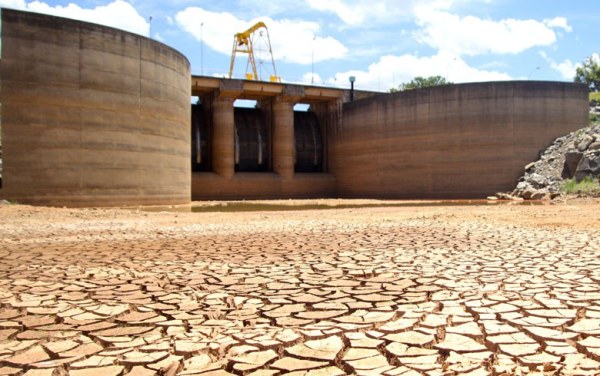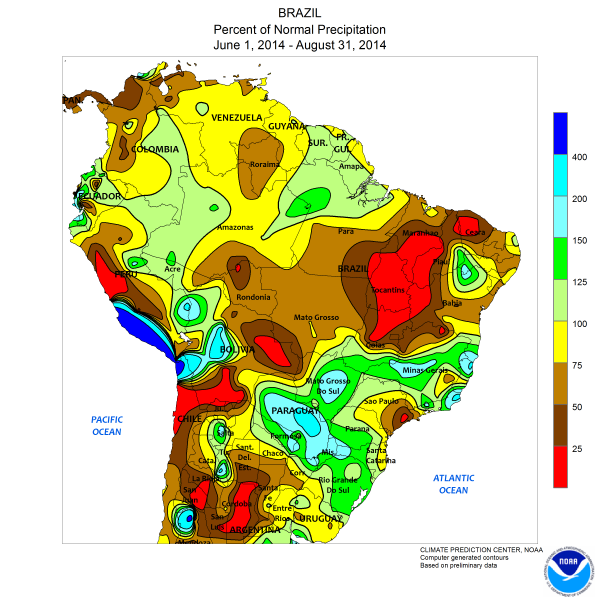Quite apart from a huge humanitarian disaster there is a disaster for the planet. From being a carbon sink an Amazon rain forest in drought turns into a source of carbon - a postive feedback
Reservoir
at 5 Percent Capacity: Climate Change to Leave Sao Paulo’s 20
Million Without Water By November?
13
October, 2014
Suffering
from its worst drought in over 84 years, the city of Sao Paulo is in
the midst of a crisis. For as of this weekend the city’s primary
reservoir — the Cantareira — had dropped to just 5 percent
capacity putting millions at risk of losing access to water.
The
fall prompted the city’s governor — Geraldo Alckmin — to again
ask for permission to draw emergency water supplies from below flood
gates to alleviate catastrophic losses from the Cantareira and ensure
water supplies to the region’s 20 million residents. The move would
tap a river system that feeds two other states also facing water
shortages — Rio de Janeiro and Minas Gerais. But the draw is
only a temporary stop gap and, without rain, the Cantareira will
continue to fall — bottoming out sometime this November.
(Dam and section of Cantareira Reservoir high and dry under incessant drought conditions. Image source: Linhas Populares.)
Don’t
Use the ‘R’ Word
The
Cantareira provides water to nearly 50 percent of Sao Paulo’s
residents. But ever since February of 2014 the multi-year long
drought, a drought that has featured less and less seasonal rainfall
over time, has triggered reduced water access by city and state
residents.
Those
living within areas served by the Cantareira have been treated to
increasing periods of dry taps — being forced to go for longer and
longer without available water supply. The intermittent lack of water
service has put a strain on businesses and residents alike with many
people living in Sao Paulo being forced to abstain from washing,
cooking and brewing. For now, water for drinking can be stored during
times when the faucets flow. But that time could come to an end all
too soon without a change in the weather.
“Sometimes
I have no water for two days, then it comes back on the next day and
the day after that, I have no water again,” said Zeina Reis da
Cruz, a 55 year old resident of one of Sao Paulo’s lower income
neighborhoods in a September 25 interview with The
Globe and Mail.
Despite
an ongoing and growing failure to provide water services, the city
refuses to use the word ‘rationing.’ Such an admission of failure
would have weighed heavily on Alckmin’s re-election campaign
(Alckmin was just recently elected to a new term as governor).
Instead, irate citizens and businesses making calls to utilities are
simply told that there is nothing wrong with the water supply and to
wait until the water comes back on.
Regardless
of politically-motivated denials, water rationing is the most
accurate way to describe what many Sao Paulo residents have been
experiencing for 9 months now under a regime of systemic drought that
just grows steadily worse with time.
Climate
Change Spurred by Deforestation, Worsened By Atmospheric Heating
The
great forest of the Amazon provides a rich source of water for both
Brazil and surrounding countries. It captures as much as 80 percent
of the tropical atmosphere’s heavy moisture load and re-circulates
it locally – providing ongoing and consistent rains. A critical
means of replenishing regional water sources.
But,
over recent decades, a combination of clear cutting and human-spurred
warming of the climate have been adding severe stresses to the
Amazon. During
the period of 2000 to 2010, the great rainforest lost 93,000 square
miles of wooded land alone to clear cutting.By
2014, government restrictions had brought down the rate of loss to
around 2,300 square miles per year, but by this time
warming-related impacts to the Amazon were looking even more dire.
As
the 2000s progressed, it was becoming ever-more-clear that a heating
climate driven by human fossil fuel emissions was taking an
increasing toll. For, during recent decades, the
Amazon has been warming at a rate of around 0.25 C every ten years —
about twice as fast as the global climate system. The added heat
increased evaporation, pushing soil moisture levels below critical
thresholds.
(It’s not just Sao Paulo, most of South America is showing ongoing rainfall deficits. Map provided by NOAA shows percent of normal precipitation received by South America this summer. Note the severe drying over much of the Amazon Rainforest and broader South America coupled with drought over Sao Paulo. Image source: Climate Prediction Center.)
This
loss has, in turn, increased the prevalence of forest-destroying
understory fires. And,
according to a 2012 NASA study these understory fires have been
burning away the Amazon at the rate of more than 30,000 square miles
every ten years for nearly two decades. By late this
Century, business
as usual fossil fuel emissions and related warming of 4 degrees
Celsius is expected to destroy about 85 percent of the Amazon,
resulting in widespread desertification of a once-lush region.
Today,
this period of initial drying caused by a human heating of the
atmosphere appears to be putting the stability of Brazil’s most
populous city at risk.
A
Major Humanitarian Disaster
Typically
for October, Sao Paulo receives between 80 and 100 mm of rainfall. So
far this month, the number is approaching zero. Long
range forecasts bring that total to just above 50 mm through
the end of the month — about half the usual rainfall. Very dry for
a month that is supposed to be the start of Sao Paulo’s rainy
season, a period that usually runs from October through March. A
rainy season once fed by a now greatly endangered and increasingly
moisture-impoverished Amazon rainforest.
It
would take a massive rainfall to replenish Sao Paulo’s reserves.
The kind of rain event that would result in widespread devastation
should it emerge. Now, city officials appear to be holding out for
any rain to tip the scales on their swiftly shrinking water stores.
But
if the worse happens. If this year is a repeat of last year which saw
a parched rainy season. If the rains of October and November continue
to delay or do not emerge at all, then Sao Paulo faces a terrible
event. A complete drying out of its largest water store and a
complete cut-off of water supplies for millions of residents.
“It
will be a real humanitarian disaster if it happens. We are 20 million
people: You can’t bring water on trucks for 20 million. So they are
praying that rainfall will come – but it may not rain so much.”
Links:
(Hat
tip to Andy)
(Hat
tip to Colorado Bob)


No comments:
Post a Comment
Note: only a member of this blog may post a comment.